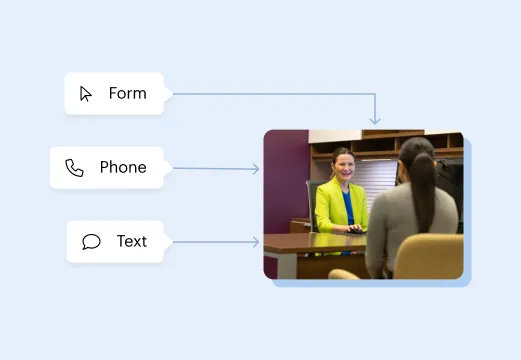Results may vary depending on your particular facts and legal circumstances. The attorney featured above is licensed in Florida. For a full list of attorneys in your state please visit our attorney page.
Whiplash From a Car Accident in Miami
Fighting for every client with the power of America's Largest Injury Law Firm.
Results may vary depending on your particular facts and legal circumstances. The attorney featured above is licensed in Florida. For a full list of attorneys in your state please visit our attorney page.
Florida Personal Injury Lawyers
We’re proud to fight for our neighbors. Meet the attorneys from your community.
100,000+ Five Star Reviews
The reasons why clients trust Morgan & Morgan.
Based on select nationwide reviews.
Results may vary depending on your particular facts and legal circumstances.
Our Results
Results may vary depending on your particular facts and legal circumstances.
How It Works
Focus on your recovery. We'll take care of the rest.

Submit your free evaluation
Start your claim

Meet your legal team

We fight for more
Results may vary depending on your particular facts and legal circumstances. The attorneys shown in these photos may not be licensed in your state. To find an attorney licensed in your area, please visit our attorney page.
Local Care
Backed by America’s Largest Injury Law Firm.
$25 Billion
Recovered for clients
nationwide700,000+
Clients and families
served1,000+
Attorneys across
the country1
Click may change your life
The attorney featured above is licensed in Florida. For a full list of attorneys in your state please visit our attorney page.
Results may vary depending on your particular facts and legal circumstances.
Learn More
Injured and not sure what to do next? We'll guide you through everything you need to know.
Get answers to commonly asked questions about our legal services and learn how we may assist you with your case.
What Is Whiplash?
Imagine your car idling at a traffic signal when all of a sudden a vehicle rams into the rear of your vehicle. Your neck and head whip back and forth with a strong enough force to cause immediate searing pain. The back and forth movement of your neck and head is called whiplash, which represents one of the most serious types of injuries that develop because of a car accident.
When your head whips back and forward with considerable velocity, the muscles and ligaments that allow you to move your head side to side stretch well beyond the point where they should stretch. The nerves that run through the neck absorb enough of an impact to cause intense pain not only in the neck, but also possibly in the shoulders as well.
Although whiplash injuries are most often associated with a rear-end car accident, you also can sustain the same injuries when a vehicle hits your car at the front or on one of the sides. Most whiplash injuries trigger immediate symptoms, but it is possible for you to experience delayed symptoms. Regardless of when the symptoms appear, you should seek medical care to prevent whiplash injuries from becoming a life-altering medical condition.
What Are the Common Symptoms of Whiplash?
When the nerves in the neck absorb a powerful impact caused by a car accident, the damage left behind generates an incredible amount of pain. The pain can be intense enough to warrant a visit to the nearest emergency medical center. Nerve damage to the neck and ensuing pain might lead to the development of prolonged migraine headaches that make it impossible to complete basic daily activities such as grocery shopping and driving the kids to school.
Another common symptom of whiplash injuries is stiffness in the neck. When neck muscles and ligaments stretch well beyond the normal point of stretching, the result is neck muscles and ligaments that remain tight enough to cause neck stiffness. A victim of whiplash might not be able to move the neck from side to side, as well as tilt the head towards the ground. Whiplash injuries that result in neck stiffness can cause pain to shoot through both arms and shoulders. You might feel numbness or tingling on one or both arms.
One of the worst outcomes of a car accident is to suffer whiplash that is severe enough to cause blurred vision and ringing in one or both ears. Damaged neck nerves also can force the body’s immune system to work overtime, which can lead to the onset of chronic fatigue.
What Is the Diagnostic Process for Whiplash Injuries?
Most of the injuries that develop because of a car accident present physical signs of distress. For example, you see the visible signs of injuries such as cuts, bruises, and fractures. The same cannot be said for whiplash, which produces symptoms that are difficult to see. This means you should visit with your physician after a car accident regardless of how serious you believe your injuries have become.
Your physician follows a three-step diagnostic process that provides insight into the seriousness of whiplash injuries. If you need a recommendation for a doctor, the whiplash lawyer representing you from Morgan & Morgan can provide one for you.
Questions
The first step of the diagnostic process involves answering several questions asked by your physician.
- How long ago did the car accident occur?
- Where did the other vehicle hit your car?
- Do you feel pain in your neck?
- Is the pain too much to take?
- Does your neck feel stiff?
- Can you move your head from side to side?
Physical Examination
The questions asked by your doctor provide an idea about how to conduct a physical examination. For example, if you explain the extent of neck stiffness, your physician can run a couple of tests to determine the seriousness of the symptoms of neck stiffness. A physical examination also gives your physician enough information to decide which diagnostic test or tests to conduct.
Imaging Tests
One or more imaging tests produce the physical evidence you need to get a claim approved, as well as win a favorable judgment awarded by a judge at the end of a civil lawsuit. Your doctor runs one or more imaging tests that include a CT scan, MRI scan, and/or x-ray. The results of imaging tests should display the damage done to your neck muscles and ligaments. Your doctor uses the information presented by imaging tests to create a customized treatment plan for your whiplash injuries.
What Are My Treatment Options for Whiplash Injuries?
Your healthcare provider develops a treatment program based on achieving three main objectives. First, your physician determines a strategy for mitigating or even eliminating the pain caused by damaged neck nerves. Second, your doctor works hard to re-establish the full range of motion for your neck. Finally, after achieving the first two main objectives, the time has come for your healthcare provider to help you transition back to a more normal lifestyle.
Managing pain represents the most urgent goal to achieve for treating whiplash injuries. Intense neck pain can disrupt your sleep patterns, as well as diminish your productivity at work, if you work at all.
Rest
You have to walk a fine line when it comes to getting enough rest. After the car accident that caused your whiplash injuries, spend the next 48 to 72 hours resting in bed. You have to lie on a supportive mattress to keep the neck stabilized. After 72 hours have passed, your physician should recommend starting light exercises to help the neck slowly build strength. Too much rest can cause neck stiffness to get worse.
Cold/Heat Packs
Your doctor determines whether to apply cold or heat packs by assessing your pain level and the extent of damaged muscles and ligaments. If you appear to tolerate the pain and your physician determines you suffer from serious neck stiffness symptoms, your physician applies a heat pack to loosen the muscles and ligaments running through your neck. Treating intense pain requires the use of cold packs. Remember that applying either type of pack is a short-term treatment solution.
Store-Bought Pain Medicine
If your doctor diagnosed minor or moderate whiplash injuries, you might be able to cope with the pain by taking an over-the-counter pain medication like Advil or Tylenol. You have to follow the instructions on the bottle to prevent taking too many pills within a 24-hour period.
Pharmacy-Bought Pain Medicine
When the pain generated by whiplash injuries becomes overwhelming, your healthcare provider can write a prescription for painkillers. Because of the potential of abuse, writing a prescription for pain medication is a serious decision that requires considerable thought. Because sleep is a crucial component of the recovery process, taking prescription pain medications can help you sleep uninterrupted to help rejuvenate both the mind and body.
What Types of Exercises Should I Do?
Under the guidance of your physician, you eventually start to perform light exercises to restore full mobility to the neck. Your doctor knows when you should start exercising the neck, as well as how hard you should push it during each session. The first exercise requires you to move your head from side to side. At first, moving your head an inch or two from side to side should loosen the neck muscles and ligaments. As you gain more mobility, you should be able to move your neck several inches from side to side.
Bending your neck towards your chest loosens the muscles and ligaments of the neck as well. However, you should not start this type of neck exercise until you have almost restored your range of neck motion from side to side. Start bending your neck slightly toward your chest before you are able to touch the chest with the tip of your chin. Performing neck exercises to recover from whiplash injuries requires a daily commitment from both you and your healthcare provider.
Do I Need to Undergo Physical Therapy?
Customized exercises might not be enough to restore normal neck movements. Physical therapy sessions offer you the opportunity to complete more strenuous exercises that strengthen your neck muscles and ligaments. Your physical therapist targets the nerves for full restoration as well. Physical therapy can help you regain the strength and flexibility you had before the car accident caused whiplash injuries.
Get the Legal Support You Deserve
Recovering from whiplash injuries requires a substantial financial investment. You can run medical expenses into tens of thousands of dollars. To ensure you present the most persuasive case to your insurance company and a judge hearing your civil lawsuit, you must submit overwhelmingly convincing evidence. By working with an experienced whiplash lawyer from Morgan & Morgan, you can build a strong enough case to recover your financial losses.
Schedule a free case evaluation today to determine the best course of legal action.
































































































































































































































































































































































































































































































































































